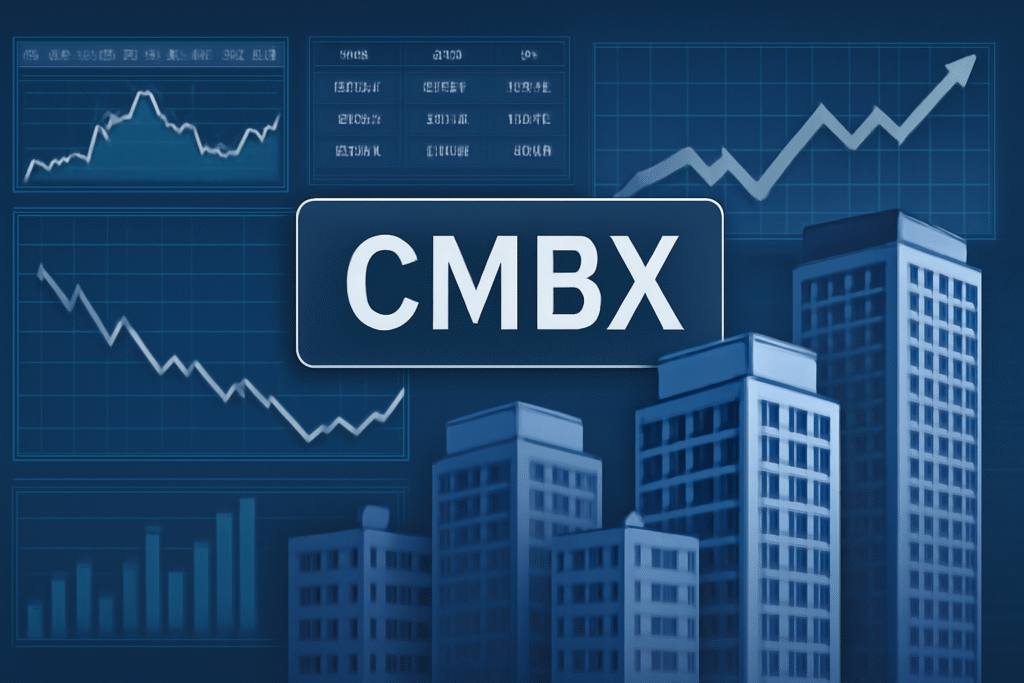CMBX stands for the Commercial Mortgage-Backed Securities Index. It is a set of tradable indices introduced in 2006 by Markit (now owned by S&P Global). Each index tracks a basket of 25 CMBS deals issued within a certain time frame, divided into tranches according to their credit ratings.
Instead of directly owning commercial mortgage-backed securities, investors use credit default swaps (CDS) tied to the CMBX indices. This synthetic exposure allows them to trade credit risk without physically holding the underlying securities.
CMBX is structured in a way that investors can choose exposure across different credit ratings, ranging from high-quality AAA tranches to riskier BBB- tranches. The result is a flexible, transparent, and standardized platform that mirrors the health of the commercial real estate debt market.
Understanding the Basics of CMBX
To grasp CMBX, it’s essential to understand its building blocks. Each series of CMBX consists of 25 CMBS deals issued during a defined time period. Within each series, there are multiple tranches: AAA, AA, A, BBB, and BBB-. Investors can either buy protection (betting against the stability of the securities) or sell protection (earning premiums in exchange for assuming risk).
This structure provides a two-way market: one for hedgers seeking insurance against defaults in commercial real estate loans, and another for speculators betting on changes in the market’s credit outlook.
In simple terms, CMBX works like a thermometer for the commercial property sector. If defaults and risks rise, the lower-rated tranches of CMBX decline in value, while those who bought protection benefit. Conversely, if the commercial real estate market performs well, protection sellers earn consistent income.
Why CMBX Matters
CMBX plays a critical role in modern financial markets for several reasons:
-
Market transparency: It standardizes exposure to commercial mortgage credit, giving investors a clear picture of market sentiment.
-
Hedging tool: Banks, insurance firms, and asset managers use CMBX to hedge credit risks in commercial property portfolios.
-
Speculative opportunity: Hedge funds employ CMBX to take directional bets on the health of commercial real estate.
-
Benchmarking: CMBX serves as a reference point for pricing and evaluating CMBS performance.
In essence, CMBX is not just a trading tool but a market signal, reflecting broader trends in real estate, credit, and economic cycles.
CMBX vs CMBS
Though they are closely related, CMBX and CMBS are not the same.
-
CMBS (Commercial Mortgage-Backed Securities): These are actual securities backed by pools of commercial mortgages, such as office buildings, hotels, and retail centers. Investors earn returns from the cash flow of these loans.
-
CMBX (Commercial Mortgage-Backed Securities Index): This is a synthetic derivative, offering exposure to CMBS credit risk without owning the securities themselves.
Together, they complement each other. CMBS investors often use CMBX to hedge or speculate, while CMBX traders rely on CMBS performance for market direction.
How CMBX Works
CMBX functions through credit default swaps. Investors can either:
-
Buy protection: Paying premiums to hedge against the possibility of defaults in commercial mortgages.
-
Sell protection: Receiving premiums in exchange for assuming risk that defaults will not occur.
The pricing of CMBX depends on credit spreads, which widen when market risks increase and tighten when risks decrease. Liquidity is supported by dealers and market makers who facilitate trades across different tranches.
Different CMBX Indices
CMBX is structured in series, with each new series representing 25 CMBS deals from a specific issuance period. Each series is divided into ratings-based tranches:
-
AAA (safest)
-
AA
-
A
-
BBB
-
BBB- (riskiest)
For example, CMBX Series 6 (CMBX 6) includes securities issued in 2012, while CMBX 15 represents deals issued in 2021. Different series carry unique characteristics, reflecting the credit environment at the time of issuance.
The Evolution of CMBX Market
Since its launch in 2006, CMBX has grown into a central part of structured finance markets. Early on, it was embraced by hedge funds as a way to short real estate during the 2008 financial crisis. The infamous “short CMBX trade” became a symbol of bearish bets against commercial mortgages.
Post-crisis, the market matured, attracting institutional investors who valued its transparency and hedging benefits. In the 2020s, CMBX again took the spotlight as retail and office real estate faced challenges from the pandemic and work-from-home shifts.
CMBX and Risk Management
Risk management is where CMBX truly shines. Portfolio managers use it to:
-
Hedge exposure: Protecting portfolios of CMBS against rising default risks.
-
Diversify holdings: Balancing commercial real estate exposure with synthetic derivatives.
-
Manage credit spreads: Using CMBX to profit from changes in credit conditions.
Its versatility makes it indispensable in managing large portfolios tied to real estate credit.
Benefits of Investing in CMBX
CMBX offers several advantages:
-
Portfolio diversification – exposure to commercial real estate without owning physical assets.
-
Liquidity – standardized trading structure makes it easier to enter or exit positions.
-
Transparency – clear tranches and pricing benchmarks aid decision-making.
-
Flexibility – ability to hedge or speculate across different credit ratings.
Risks Associated with CMBX
Like any investment, CMBX carries risks:
-
Market volatility: CMBX spreads can widen dramatically in downturns.
-
Credit risk: Defaults in commercial mortgages can impact returns.
-
Liquidity risk: While generally liquid, some series may face reduced trading activity.
-
Complexity: Understanding CMBX requires expertise in derivatives and structured finance.
Who Invests in CMBX?
CMBX attracts a range of players:
-
Institutional investors: Pension funds and insurers seeking hedging tools.
-
Hedge funds: Using CMBX for speculative trades.
-
Banks: Hedging credit exposures from commercial real estate loans.
-
Asset managers: Adding diversification and managing risk.
Role of CMBX in Real Estate
CMBX is deeply tied to commercial property markets. Its spreads often serve as a barometer for the health of real estate sectors such as retail, hotels, and office buildings. When property values fall, CMBX spreads typically widen, signaling stress.
This dynamic influences lending decisions, valuations, and investor sentiment across the real estate industry.
CMBX and Short Selling
Short selling is one of the most famous uses of CMBX. Traders can buy protection on lower-rated tranches, effectively betting on rising defaults. This strategy became legendary during the financial crisis, with some hedge funds making fortunes by shorting CMBX ahead of the 2008 collapse.
CMBX During Economic Downturns
CMBX is especially relevant in downturns.
-
2008 crisis: Shorting CMBX became symbolic of the collapse in commercial real estate debt.
-
COVID-19: The pandemic hit retail and hotel properties hard, causing spreads to widen sharply.
These periods showed how CMBX reflects real-world stress in property markets.
Regulatory Environment of CMBX
CMBX operates within the broader framework of derivatives regulation. The SEC and CFTC oversee aspects of transparency, while post-crisis reforms improved reporting and reduced systemic risks.
CMBX as a Benchmark Tool
CMBX serves as a benchmark for:
-
Pricing CMBS securities
-
Measuring credit risk in commercial real estate
-
Comparing performance across tranches and series
Technology and CMBX
With the rise of electronic trading, analytics, and AI, CMBX markets have become more efficient. Algorithms now analyze spreads, correlations, and risks in real time, giving traders faster decision-making tools.
Case Studies on CMBX
Several famous cases illustrate CMBX’s role:
-
Hedge funds shorting retail-linked CMBX during the “retail apocalypse.”
-
Institutional investors using CMBX to hedge hotel exposure during COVID-19.
-
Traders speculating on office sector weakness post-pandemic.
Myths and Misconceptions About CMBX
Despite its growth, CMBX is often misunderstood:
-
Myth: It is too risky for all investors.
-
Reality: Risk depends on tranche selection and strategy.
-
Myth: Only hedge funds can use it.
-
Reality: Institutional investors also rely on it.
-
Myth: It lacks liquidity.
-
Reality: Major series are liquid and actively traded.
Global Perspective on CMBX
CMBX is primarily a U.S.-based product, reflecting the American dominance in structured finance. However, similar instruments may emerge globally as commercial real estate markets mature.
How to Start Investing in CMBX
Getting started requires:
-
A brokerage account with access to derivatives markets.
-
Understanding of credit default swaps.
-
Sufficient capital and risk management strategies.
Strategies for Success with CMBX
Successful investors often combine strategies:
-
Long-term hedging against credit downturns.
-
Tactical trading of spreads across tranches.
-
Diversification with other credit instruments.
Future of CMBX Market
The future of CMBX will be shaped by:
-
Shifts in real estate markets (office, retail, hospitality).
-
Advances in technology and analytics.
-
Global adoption of synthetic real estate indices.
FAQs
What is CMBX used for?
CMBX is used for hedging credit risks, speculating on commercial real estate, and benchmarking CMBS performance.
How does CMBX differ from CMBS?
CMBS are actual securities backed by mortgages, while CMBX is a synthetic index linked to those securities.
Who invests in CMBX?
Hedge funds, banks, insurance firms, and institutional investors are the main participants.
Is CMBX risky?
Yes, especially in lower-rated tranches. However, risk depends on the investor’s strategy and exposure.
Why did CMBX make headlines during COVID-19?
Because commercial real estate sectors like retail and hotels faced huge stress, causing spreads in certain CMBX tranches to widen dramatically.
Can retail investors access CMBX?
Direct access is limited due to its complexity, but some funds offer indirect exposure.
Conclusion
CMBX is more than just a financial acronym—it is a vital tool for understanding, hedging, and investing in commercial real estate debt. From its origins in 2006 to its starring role in financial crises, it has proven to be a powerful barometer of credit health.
For investors, CMBX offers opportunities to diversify, manage risks, and even profit from downturns. But it also demands caution, expertise, and a solid understanding of its structure and risks.
As commercial property markets continue to evolve in the face of economic and technological changes, CMBX will remain at the heart of real estate finance, shaping strategies and reflecting market realities for years to come.



